Exploring the Potential of SnHPO3 and Ni3.4Sn4 as Anode Materials in Argyrodite-Based All-Solid-State Lithium-Ion Batteries
Abstract
1. Introduction
2. Materials and Methods
2.1. Synthesis of Nanostructured Tin-Based Anodes
2.2. Preparation of Li6PS5Cl Solid Electrolyte
2.3. Materials Characterization
2.3.1. Structural, Morphological, and Microstructural Characterization
2.3.2. Electrochemical Measurements
3. Results
3.1. Structure and Morphology of Sn-Based Active Materials
3.1.1. Nanostructured SnHPO3 Tin Phosphite
3.1.2. Nanostructured Ni3.4Sn4 Intermetallic
3.2. Li6PS5Cl Solid Electrolyte
3.2.1. Structural and Morphological Characterization
3.2.2. Electrochemical Characterization
3.3. Electrochemical Characterization of Sn-Based All-Solid-State Half-Cell
4. Discussion
5. Conclusions
Supplementary Materials
Author Contributions
Funding
Data Availability Statement
Acknowledgments
Conflicts of Interest
References
- Yu, C.; Zhao, F.; Luo, J.; Zhang, L.; Sun, X. Recent Development of Lithium Argyrodite Solid-State Electrolytes for Solid-State Batteries: Synthesis, Structure, Stability and Dynamics. Nano Energy 2021, 83, 105858. [Google Scholar] [CrossRef]
- Wang, D.; Shi, H.; Cui, W.; Li, H.; Niu, J.; Wang, S.; Xu, Z. Li-Argyrodite Solid-State Electrolytes with Lithium Compatibility and Air Stability for All-Solid-State Batteries. J. Mater. Chem. A 2024, 12, 10863–10874. [Google Scholar] [CrossRef]
- Zoubir, O.; Lallaoui, A.; Edfouf, Z. Electrolyte Additives for Bulk-Type All-Oxide Solid-State Lithium-Ion Batteries. J. Energy Storage 2024, 104, 114592. [Google Scholar] [CrossRef]
- Wu, J.; Shen, L.; Zhang, Z.; Liu, G.; Wang, Z.; Zhou, D.; Wan, H.; Xu, X.; Yao, X. All-Solid-State Lithium Batteries with Sulfide Electrolytes and Oxide Cathodes. Electrochem. Energy Rev. 2021, 4, 101–135. [Google Scholar] [CrossRef]
- Park, J.-S.; Jo, C.-H.; Myung, S.-T. Comprehensive Understanding on Lithium Argyrodite Electrolytes for Stable and Safe All-Solid-State Lithium Batteries. Energy Storage Mater. 2023, 61, 102869. [Google Scholar] [CrossRef]
- Divakaran, A.M.; Minakshi, M.; Bahri, P.A.; Paul, S.; Kumari, P.; Divakaran, A.M.; Manjunatha, K.N. Rational Design on Materials for Developing next Generation Lithium-Ion Secondary Battery. Prog. Solid State Chem. 2021, 62, 100298. [Google Scholar] [CrossRef]
- Divakaran, A.M.; Hamilton, D.; Manjunatha, K.N.; Minakshi, M. Design, Development and Thermal Analysis of Reusable Li-Ion Battery Module for Future Mobile and Stationary Applications. Energies 2020, 13, 1477. [Google Scholar] [CrossRef]
- Zhang, S.; Sun, Q.; Martínez-Alanis, P.R.; Chen, G.; Li, J.; Zeng, G.; Biendicho, J.J.; Ci, L.; Cabot, A. Towards Flame Retardant High-Performance Solid-State Lithium Metal Batteries: Poly(Ionic Liquid)-Based Lithiophilic Ion-Conductive Interfaces and Humidity Tolerant Binders. Nano Energy 2025, 133, 110424. [Google Scholar] [CrossRef]
- Sung, J.; Kim, S.Y.; Harutyunyan, A.; Amirmaleki, M.; Lee, Y.; Son, Y.; Li, J. Ultra-Thin Lithium Silicide Interlayer for Solid-State Lithium-Metal Batteries. Adv. Mater. 2023, 35, 2210835. [Google Scholar] [CrossRef]
- Liang, J.; Li, X.; Zhao, Y.; Goncharova, L.V.; Wang, G.; Adair, K.R.; Wang, C.; Li, R.; Zhu, Y.; Qian, Y.; et al. In Situ Li3PS4 Solid-State Electrolyte Protection Layers for Superior Long-Life and High-Rate Lithium-Metal Anodes. Adv. Mater. 2018, 30, 1804684. [Google Scholar] [CrossRef]
- Palaniselvam, T.; Freytag, A.I.; Moon, H.; Janßen, K.A.; Passerini, S.; Adelhelm, P. Tin–Graphite Composite as a High-Capacity Anode for All-Solid-State Li-Ion Batteries. J. Phys. Chem. C 2022, 126, 13043–13052. [Google Scholar] [CrossRef]
- Kreissl, J.J.A.; Dang, H.A.; Mogwitz, B.; Rohnke, M.; Schröder, D.; Janek, J. Implementation of Different Conversion/Alloy Active Materials as Anodes for Lithium-Based Solid-State Batteries. ACS Appl. Mater. Interfaces 2024, 16, 26195–26208. [Google Scholar] [CrossRef] [PubMed]
- Ueda, A.; Nagao, M.; Inoue, A.; Hayashi, A.; Seino, Y.; Ota, T.; Tatsumisago, M. Electrochemical Performance of All-Solid-State Lithium Batteries with Sn4P3 Negative Electrode. J. Power Sources 2013, 244, 597–600. [Google Scholar] [CrossRef]
- Sun, Q.; Zeng, G.; Xu, X.; Li, J.; Biendicho, J.J.; Wang, S.; Tian, Y.; Ci, L.; Cabot, A. Are Sulfide-Based Solid-State Electrolytes the Best Pair for Si Anodes in Li-Ion Batteries? Adv. Energy Mater. 2024, 14, 2402048. [Google Scholar] [CrossRef]
- Miyazaki, R.; Hihara, T. Charge-Discharge Performances of Sn Powder as a High-Capacity Anode for All-Solid-State Lithium Batteries. J. Power Sources 2019, 427, 15–20. [Google Scholar] [CrossRef]
- Huang, Y.; Shao, B.; Wang, Y.; Han, F. Solid-State Silicon Anode with Extremely High Initial Coulombic Efficiency. Energy Environ. Sci. 2023, 16, 1569–1580. [Google Scholar] [CrossRef]
- Li, J.; Su, H.; Liu, Y.; Zhong, Y.; Wang, X.; Tu, J. Li Alloys in All Solid-State Lithium Batteries: A Review of Fundamentals and Applications. Electrochem. Energy Rev. 2024, 7, 18. [Google Scholar] [CrossRef]
- Bezza, I.; Trouillet, V.; Fiedler, A.; Bruns, M.; Indris, S.; Ehrenberg, H.; Saadoune, I. Understanding the Lithiation/Delithiation Process in SnP2O7 Anode Material for Lithium-Ion Batteries. Electrochim. Acta 2017, 252, 446–452. [Google Scholar] [CrossRef]
- Jeong, W.J.; Wang, C.; Yoon, S.G.; Liu, Y.; Chen, T.; McDowell, M.T. Electrochemical Behavior of Elemental Alloy Anodes in Solid-State Batteries. ACS Energy Lett. 2024, 9, 2554–2563. [Google Scholar] [CrossRef]
- Ehinon, K.K.D.; Naille, S.; Dedryvère, R.; Lippens, P.-E.; Jumas, J.-C.; Gonbeau, D. Ni3Sn4 Electrodes for Li-Ion Batteries: Li−Sn Alloying Process and Electrode/Electrolyte Interface Phenomena. Chem. Mater. 2008, 20, 5388–5398. [Google Scholar] [CrossRef]
- Wu, X.; Billaud, J.; Jerjen, I.; Marone, F.; Ishihara, Y.; Adachi, M.; Adachi, Y.; Villevieille, C.; Kato, Y. Operando Visualization of Morphological Dynamics in All-Solid-State Batteries. Adv. Energy Mater. 2019, 9, 1901547. [Google Scholar] [CrossRef]
- Edfouf, Z.; Fariaut-Georges, C.; Cuevas, F.; Latroche, M.; Hézèque, T.; Caillon, G.; Jordy, C.; Sougrati, M.T.; Jumas, J.C. Nanostructured Ni3.5Sn4 Intermetallic Compound: An Efficient Buffering Material for Si-Containing Composite Anodes in Lithium Ion Batteries. Electrochim. Acta 2013, 89, 365–371. [Google Scholar] [CrossRef]
- Tout, W.; Mateos, M.; Zhang, J.; Oubla, M.; Emery, N.; Leroy, E.; Dubot, P.; El Moursli, F.C.; Edfouf, Z.; Cuevas, F. Unraveling the energy storage mechanism in nanostructured SnHPO3 anode through advanced operando and ex-situ characterizations. J. Energy Storage 2025, 112, 115502. [Google Scholar] [CrossRef]
- Furuseth, S.; Fjellvag, H. Structural Properties of Ni3+xSn4. Acta Chem. Scand. A 1986, 40, 695–700. [Google Scholar]
- Schmetterer, C.; Flandorfer, H.; Richter, K.W.; Saeed, U.; Kauffman, M.; Roussel, P.; Ipser, H. A New Investigation of the System Ni–Sn. Intermetallics 2007, 15, 869–884. [Google Scholar] [CrossRef]
- Rodríguez-Carvajal, J. Recent Advances in Magnetic Structure Determination by Neutron Powder Diffraction. Phys. B Condens. Matter 1993, 192, 55–69. [Google Scholar] [CrossRef]
- Ares, J.R.; Cuevas, F.; Percheron-Guégan, A. Mechanical Milling and Subsequent Annealing Effects on the Microstructural and Hydrogenation Properties of Multisubstituted LaNi5 Alloy. Acta Mater. 2005, 53, 2157–2167. [Google Scholar] [CrossRef]
- McDonald, R.C.; Eriks, K. Crystallographic Studies of Tin(II) Compounds. 2. Structures of Tin(II) Hydrogen Phosphate and Tin(II) Phosphite, SnHPO4 and SnHPO3. Inorg. Chem. 1980, 19, 1237–1241. [Google Scholar] [CrossRef]
- Rao, R.P.; Adams, S. Studies of Lithium Argyrodite Solid Electrolytes for All-Solid-State Batteries. Phys. Status Solidi (A) 2011, 208, 1804–1807. [Google Scholar] [CrossRef]
- Boulineau, S.; Courty, M.; Tarascon, J.-M.; Viallet, V. Mechanochemical Synthesis of Li-Argyrodite Li6PS5X (X = Cl, Br, I) as Sulfur-Based Solid Electrolytes for All Solid-State Batteries Application. Solid State Ion. 2012, 221, 1–5. [Google Scholar] [CrossRef]
- Liu, Y.; Peng, H.; Su, H.; Zhong, Y.; Wang, X.; Xia, X.; Gu, C.; Tu, J. Ultrafast Synthesis of I-Rich Lithium Argyrodite Glass–Ceramic Electrolyte with High Ionic Conductivity. Adv. Mater. 2022, 34, 2107346. [Google Scholar] [CrossRef] [PubMed]
- De Klerk, N.J.; Rosłoń, I.; Wagemaker, M. Diffusion mechanism of Li argyrodite solid electrolytes for Li-ion batteries and prediction of optimized halogen doping: The effect of Li vacancies, halogens, and halogen disorder. Chem. Mater. 2016, 28, 7955–7963. [Google Scholar] [CrossRef]
- Kraft, M.A.; Culver, S.P.; Calderon, M.; Böcher, F.; Krauskopf, T.; Senyshyn, A.; Dietrich, C.; Zevalkink, A.; Janek, J.; Zeier, W.G. Influence of Lattice Polarizability on the Ionic Conductivity in the Lithium Superionic Argyrodites Li6PS5X (X = Cl, Br, I). J. Am. Chem. Soc. 2017, 139, 10909–10918. [Google Scholar] [CrossRef] [PubMed]
- Hanghofer, I.; Gadermaier, B.; Wilkening, H.M.R. Fast Rotational Dynamics in Argyrodite-Type Li6PS5X (X: Cl, Br, I) as Seen by 31P Nuclear Magnetic Relaxation-On Cation–Anion Coupled Transport in Thiophosphates. Chem. Mater. 2019, 31, 4591–4597. [Google Scholar] [CrossRef]
- Peng, L.; Yu, C.; Zhang, Z.; Ren, H.; Zhang, J.; He, Z.; Yu, M.; Zhang, L.; Cheng, S.; Xie, J. Chlorine-Rich Lithium Argyrodite Enabling Solid-State Batteries with Capabilities of High Voltage, High Rate, Low-Temperature and Ultralong Cyclability. Chem. Eng. J. 2022, 430, 132896. [Google Scholar] [CrossRef]
- Tan, D.H.S.; Wu, E.A.; Nguyen, H.; Chen, Z.; Marple, M.A.T.; Doux, J.-M.; Wang, X.; Yang, H.; Banerjee, A.; Meng, Y.S. Elucidating Reversible Electrochemical Redox of Li6PS5Cl Solid Electrolyte. ACS Energy Lett. 2019, 4, 2418–2427. [Google Scholar] [CrossRef]
- Haruna, A.B.; Mofokeng, T.P.; Ogada, J.J.; Zoubir, O.; Lallaoui, A.; El Moursli, F.C.; Ozoemena, K.I. Recent advances in the cathode materials and solid-state electrolytes for lithium sulfur batteries. Electrochem. Commun. 2022, 136, 107248. [Google Scholar] [CrossRef]
- Lee, H.; Oh, P.; Kim, J.; Cha, H.; Chae, S.; Lee, S.; Cho, J. Advances and Prospects of Sulfide All-Solid-State Lithium Batteries via One-to-One Comparison with Conventional Liquid Lithium-Ion Batteries. Adv. Mater. 2019, 31, 1900376. [Google Scholar] [CrossRef]
- Liang, Z.; Xiang, Y.; Wang, K.; Zhu, J.; Jin, Y.; Wang, H.; Zheng, B.; Chen, Z.; Tao, M.; Liu, X.; et al. Understanding the Failure Process of Sulfide-Based All-Solid-State Lithium Batteries via Operando Nuclear Magnetic Resonance Spectroscopy. Nat. Commun. 2023, 14, 259. [Google Scholar] [CrossRef]
- Zhang, W.; Leichtweiß, T.; Culver, S.P.; Koerver, R.; Das, D.; Weber, D.A.; Janek, J. The Detrimental Effects of Carbon Additives in Li10GeP2S12-Based Solid-State Batteries. ACS Appl. Mater. Interfaces 2017, 9, 35888–35896. [Google Scholar] [CrossRef]
- Tan, D.H.S.; Chen, Y.-T.; Yang, H.; Bao, W.; Sreenarayanan, B.; Doux, J.-M.; Li, W.; Lu, B.; Ham, S.-Y.; Sayahpour, B.; et al. Carbon-Free High-Loading Silicon Anodes Enabled by Sulfide Solid Electrolytes. Science 2021, 373, 1494–1499. [Google Scholar] [CrossRef]
- Suryanarayana, C. Mechanical alloying and milling. Prog. Mater. Sci. 2001, 46, 1–184. [Google Scholar]
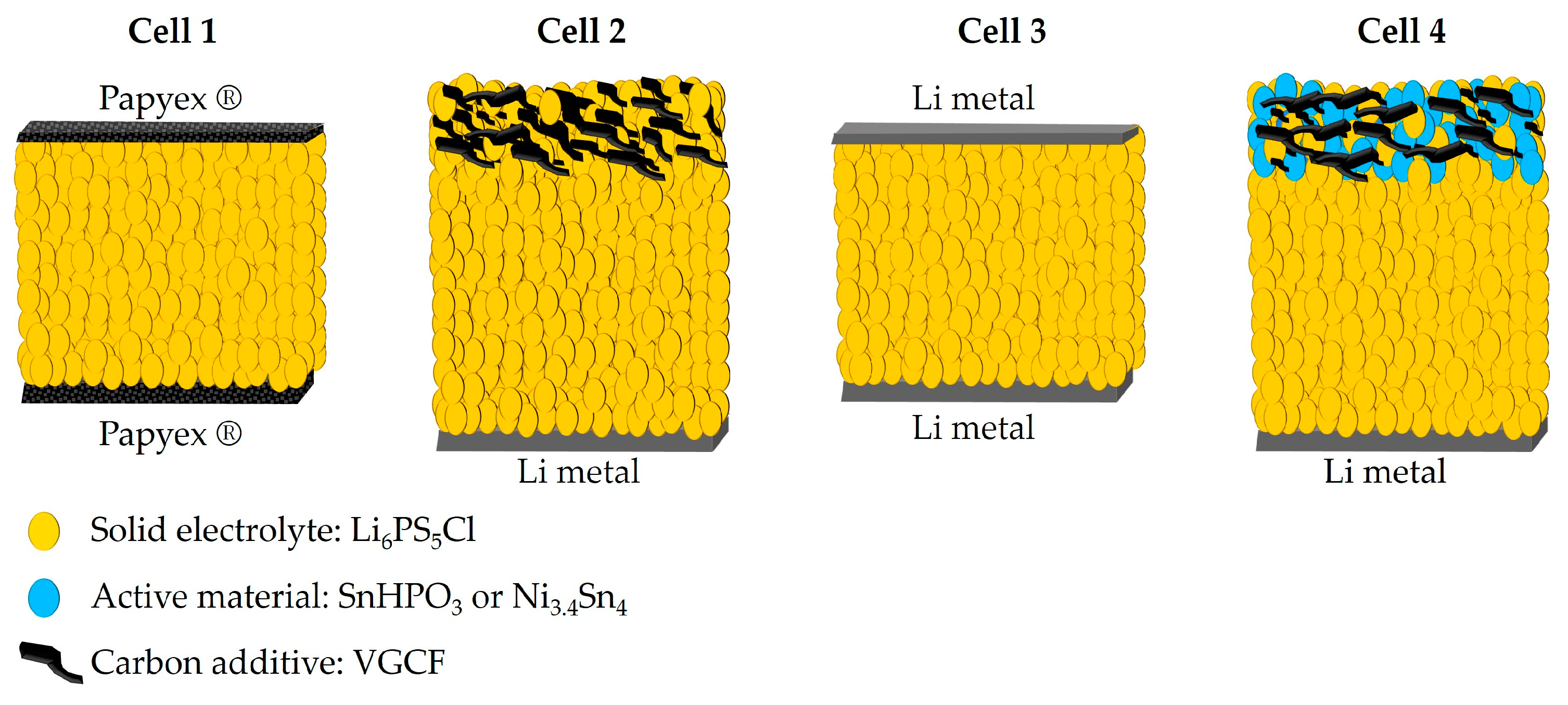
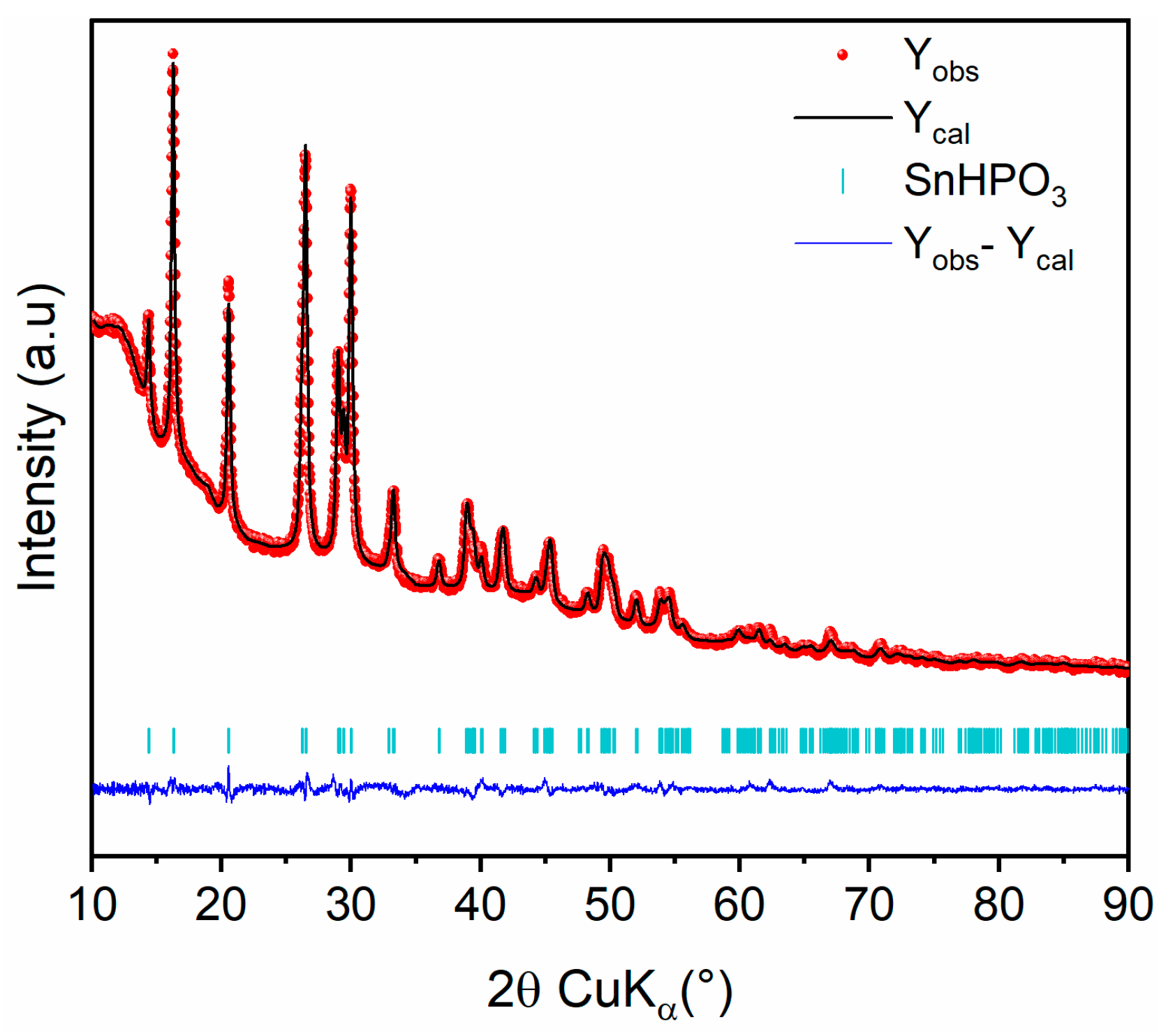
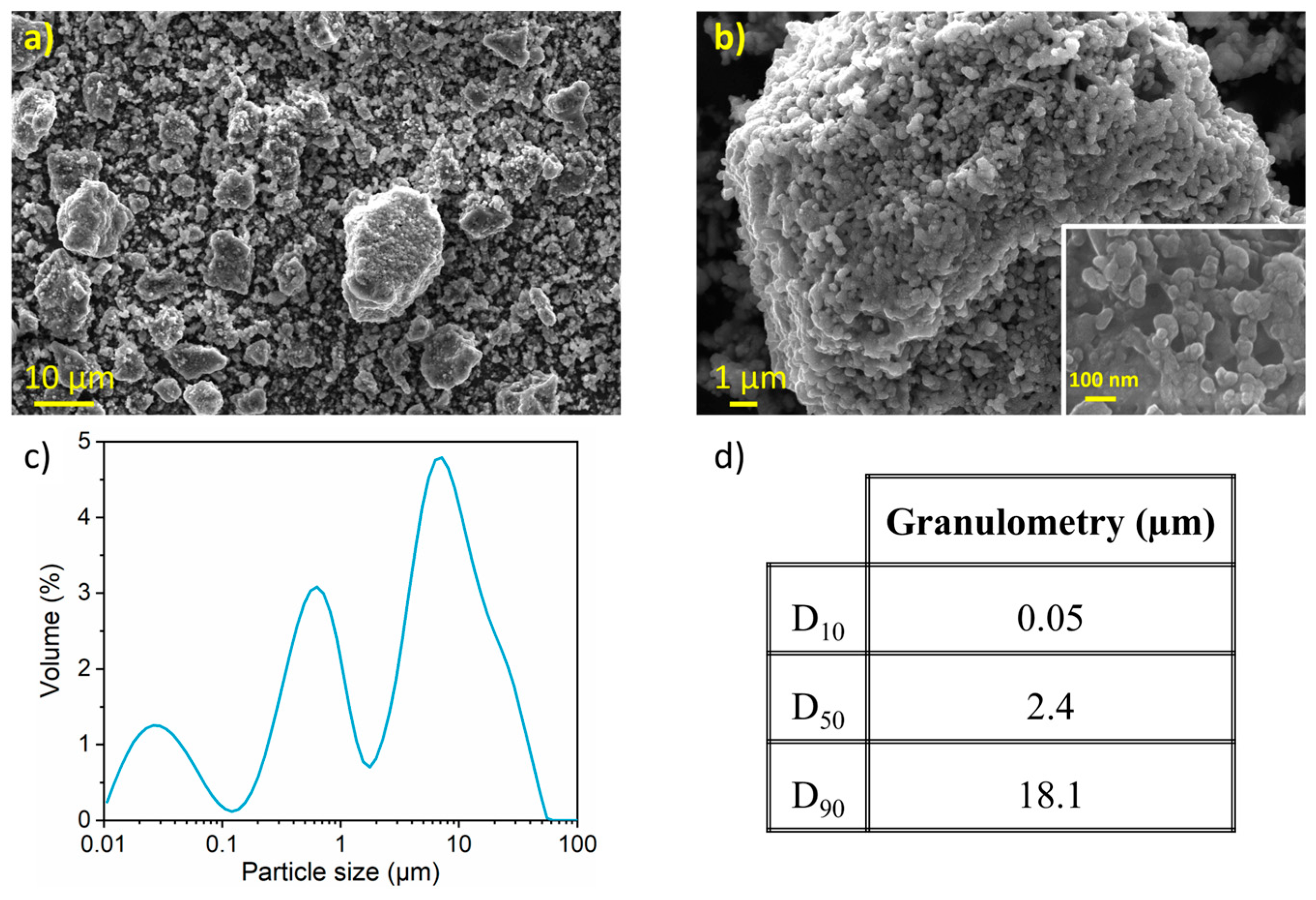
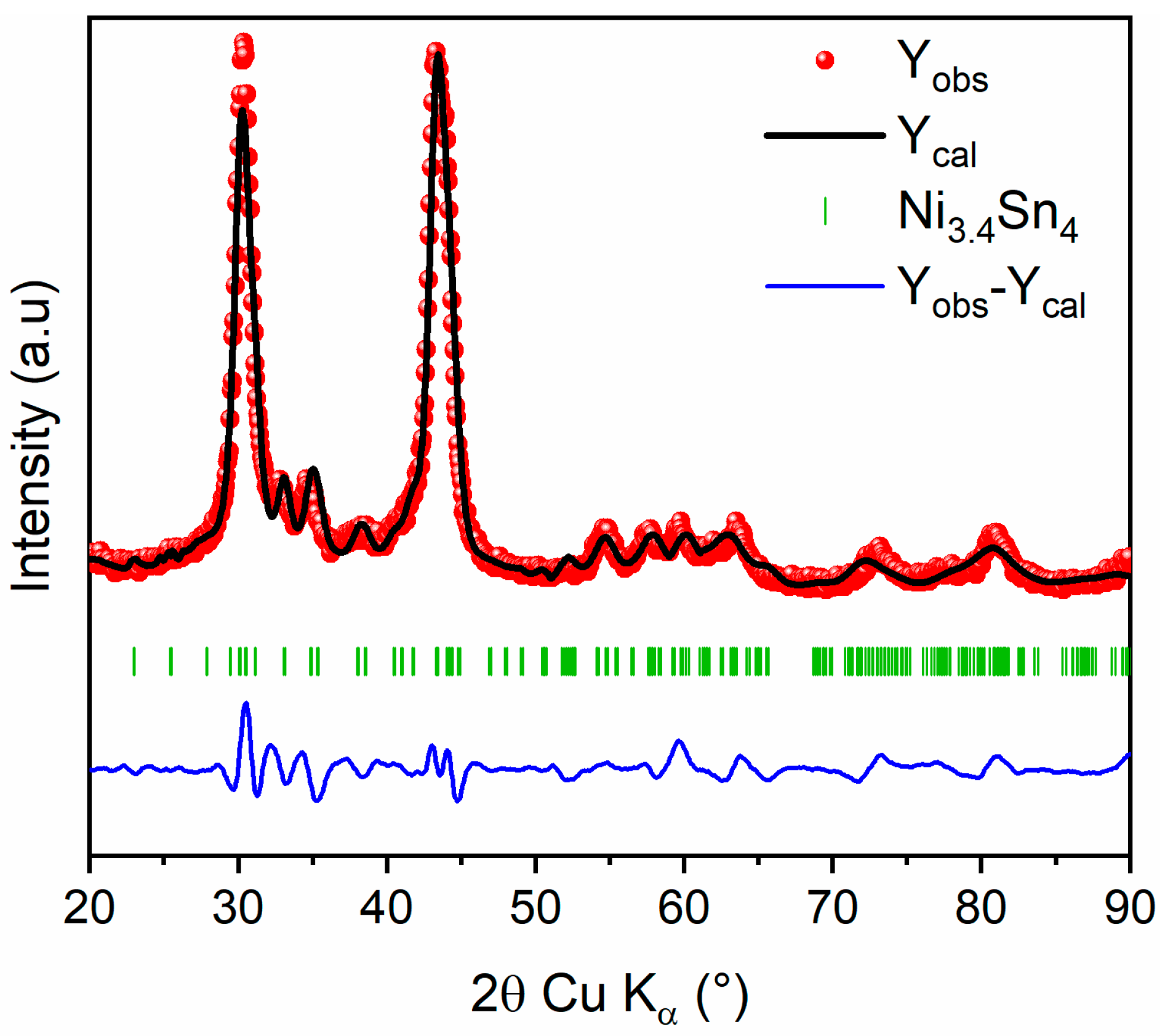
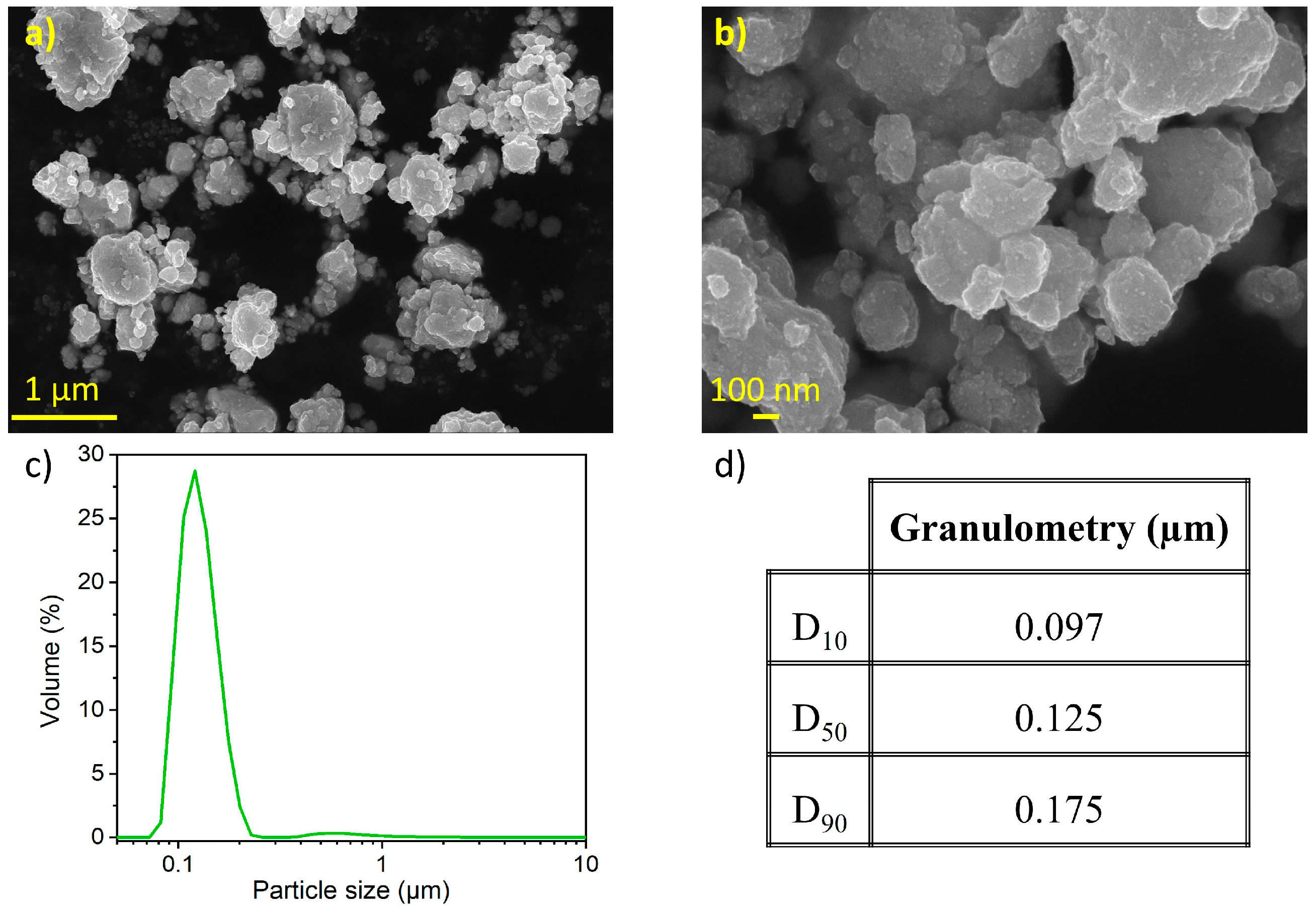



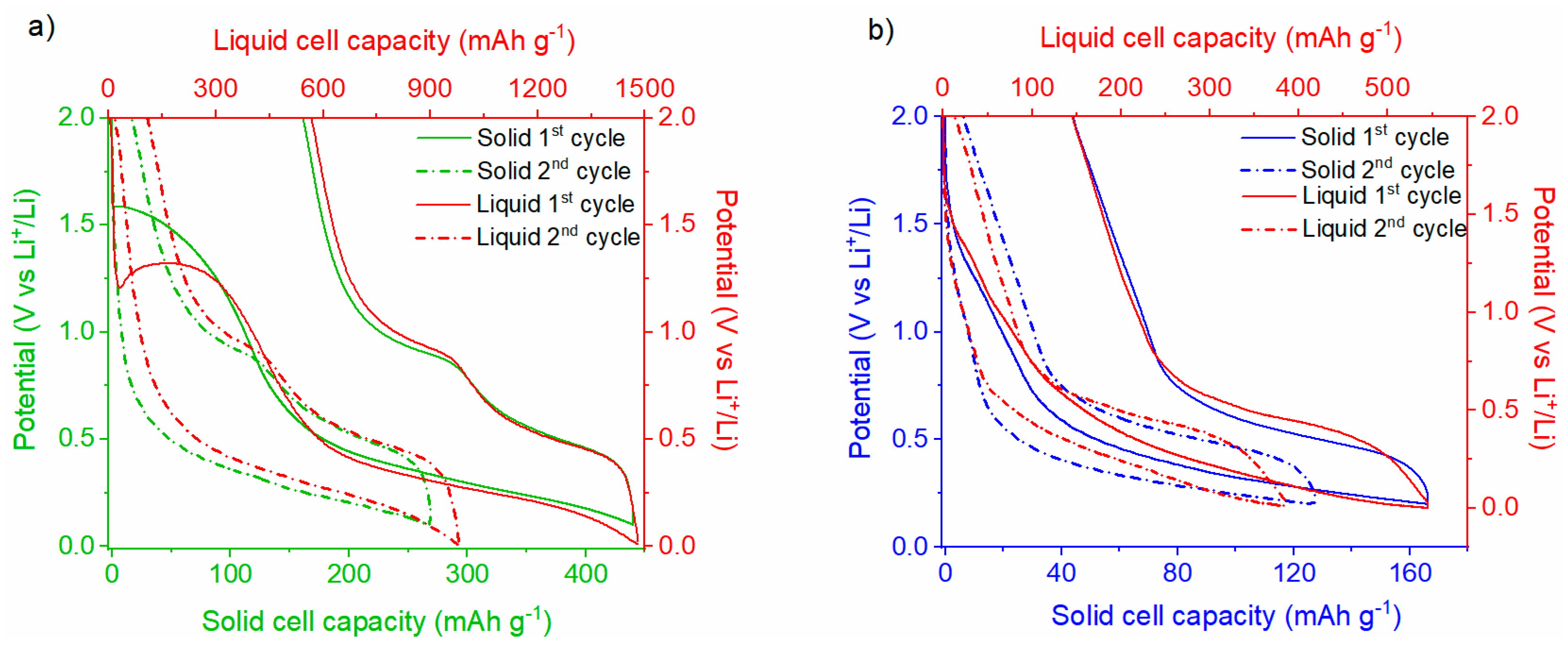
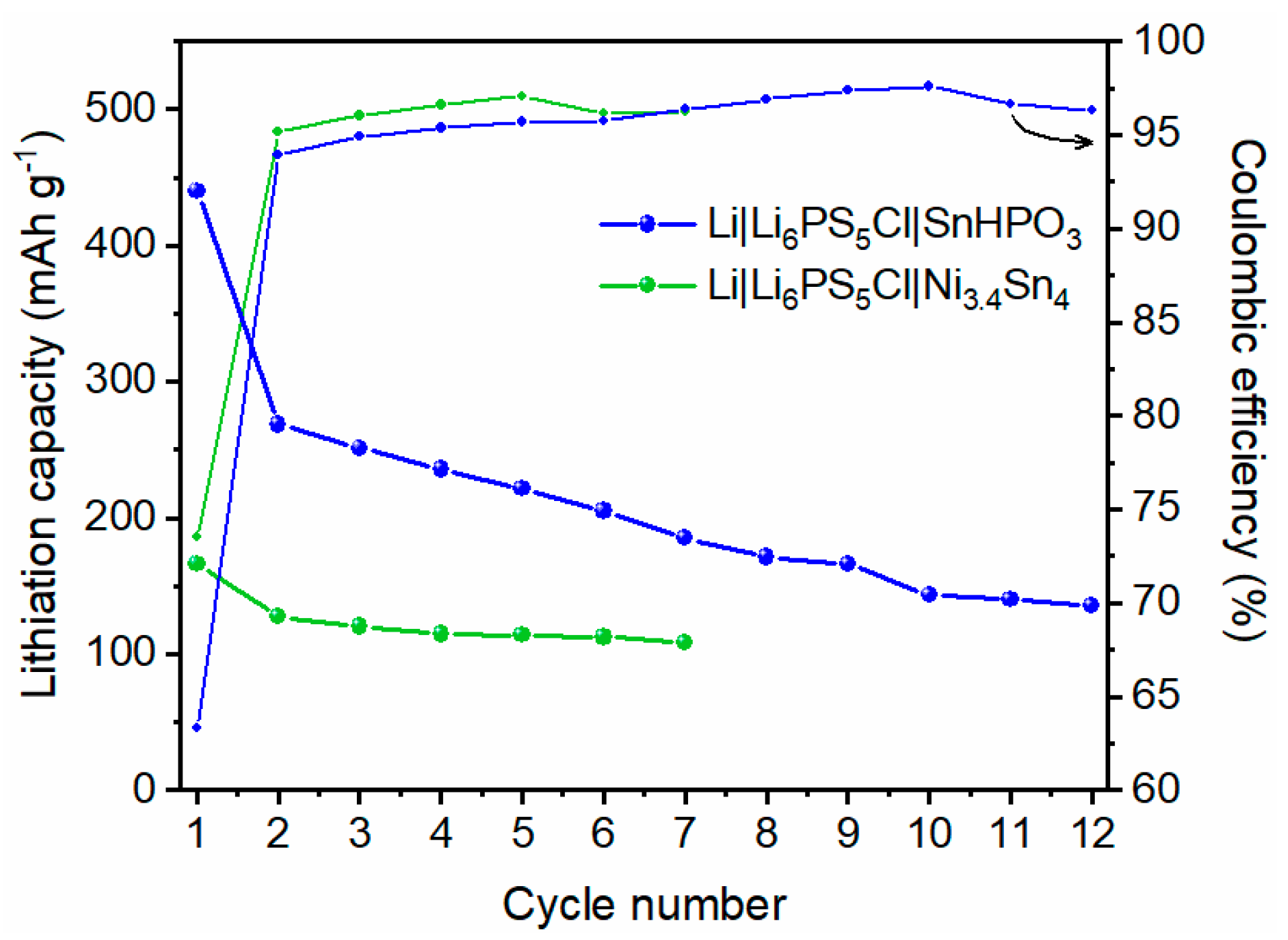
| Unit Cell Parameters | Density (g cm−3) | Crystallite Size (nm) | |||
|---|---|---|---|---|---|
| a (Å) | b (Å) | c (Å) | β (°) | ||
| 7.0730 (2) | 12.3153 (4) | 4.6802 (2) | 120.894 (2) | 3.7 | 24 (2) |
| RBragg = 3.2 | Rp = 12.6 | Rwp = 9.5 | χ2 = 2.3 | ||
| Sample | Metal-Content | ICP Composition | ||
|---|---|---|---|---|
| at.% Ni | at.% Sn | at.% Fe | ||
| Non-milled Ni3.4Sn4 | 46.35 | 53.61 | 0.04 | Ni3.5(1)Sn4 |
| 20 h milled Ni3.4Sn4 | 46.62 | 53.29 | 0.09 | |
| Unit Cell Parameters | Density (g cm−3) | Crystallite Size (nm) | |||
|---|---|---|---|---|---|
| a (Å) | b (Å) | c (Å) | β (°) | ||
| 12.5053 (7) | 4.0872 (2) | 5.2342 (3) | 103.917 (9) | 8.5 | 7 (1) |
| RBragg = 5.7 | Rp = 17.5 | Rwp = 17.7 | χ2 = 4.6 | ||
| Unit Cell Parameter a (Å) | Density (g cm−3) | Crystallite Size (nm) | |||
|---|---|---|---|---|---|
| 9.8495 (5) | 1.9 | 15 (1) | |||
| RBragg = 2.9 | Rp = 15.4 | Rwp = 11.7 | χ2 = 2.3 | ||
| Atom | Wyckoff Site | Atomic Positions | SOF | ||
| x | y | z | |||
| Li | 48h | 0.1989 | 0.1989 | 0.0025 | 0.44 |
| Li | 24g | 0.0538 | 0.2500 | 0.2500 | 0.12 |
| S | 16e | 0.6204 (3) | 0.6204 (3) | 0.6204 (3) | 1 |
| Cl | 4c | 1 | |||
| S | |||||
| P | 4b | 1 | |||
| S | 4a | 0 | 0 | 0 | 1 |
| Cl | |||||
Disclaimer/Publisher’s Note: The statements, opinions and data contained in all publications are solely those of the individual author(s) and contributor(s) and not of MDPI and/or the editor(s). MDPI and/or the editor(s) disclaim responsibility for any injury to people or property resulting from any ideas, methods, instructions or products referred to in the content. |
© 2025 by the authors. Licensee MDPI, Basel, Switzerland. This article is an open access article distributed under the terms and conditions of the Creative Commons Attribution (CC BY) license (https://creativecommons.org/licenses/by/4.0/).
Share and Cite
Tout, W.; Zhang, J.; Mateos, M.; Oubla, M.; Cherkaoui El Moursli, F.; Cuevas, F.; Edfouf, Z. Exploring the Potential of SnHPO3 and Ni3.4Sn4 as Anode Materials in Argyrodite-Based All-Solid-State Lithium-Ion Batteries. Nanomaterials 2025, 15, 512. https://doi.org/10.3390/nano15070512
Tout W, Zhang J, Mateos M, Oubla M, Cherkaoui El Moursli F, Cuevas F, Edfouf Z. Exploring the Potential of SnHPO3 and Ni3.4Sn4 as Anode Materials in Argyrodite-Based All-Solid-State Lithium-Ion Batteries. Nanomaterials. 2025; 15(7):512. https://doi.org/10.3390/nano15070512
Chicago/Turabian StyleTout, Wissal, Junxian Zhang, Mickael Mateos, M’hamed Oubla, Fouzia Cherkaoui El Moursli, Fermin Cuevas, and Zineb Edfouf. 2025. "Exploring the Potential of SnHPO3 and Ni3.4Sn4 as Anode Materials in Argyrodite-Based All-Solid-State Lithium-Ion Batteries" Nanomaterials 15, no. 7: 512. https://doi.org/10.3390/nano15070512
APA StyleTout, W., Zhang, J., Mateos, M., Oubla, M., Cherkaoui El Moursli, F., Cuevas, F., & Edfouf, Z. (2025). Exploring the Potential of SnHPO3 and Ni3.4Sn4 as Anode Materials in Argyrodite-Based All-Solid-State Lithium-Ion Batteries. Nanomaterials, 15(7), 512. https://doi.org/10.3390/nano15070512







